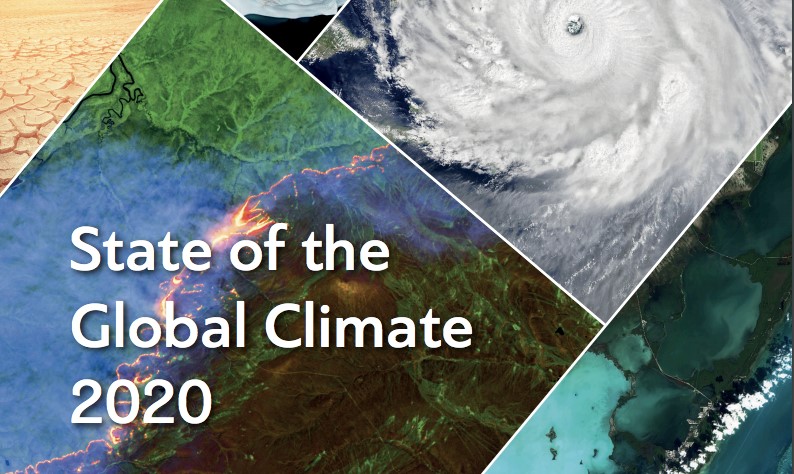“Sustainable development is threatened, with food and water insecurity, health risks and environmental degradation on the rise”, threatens a recent report by WMO.
Just days before COP26 to be held at Glasgow, another report has highlighted the very impacts of climate change we have been witnessing in disregard.
The State of the Climate in Asia report 2020, released by World Meteorological Organization (WMO), has drawn the world’s attention to extreme weather events across Asia in 2those occurred back in 2020 and the reason underneath.
These grave events have extinguished at least thousands of lives, displaced millions, slapped economy with billions of dollars and at times hampered growth and recovery.
Not alone lives but several man-made infrastructures and natural ecosystems got affected.
India alone has suffered an average economic loss of about $87 billion just from extreme weather events in its vicinity like the tropical cyclones, floods, excessive rainfalls or droughts etc.
Floods and storms alone shattered nearly 50 million livelihoods, including over 5,000 people who lost their lives.
The report talks of these unfortunate events impeding any progress made in attaining the sustainable development goals or activities in this regard.
An average estimate of these losses brings an average annual loss (AAL) close to billions of dollars, which refers to the long-term (averaged over many years associated with hazards) expected losses per year.
Why 2020 suffered the blow?
Each year, the Earth has been breaking its own records for heat stress. Higher temperatures trigger the Earth dynamics for mechanisms like cyclones.
In 2020, both the South and East Asian summer monsoons were unusually active and caused floods and landslides troubling the frontier nations.
Average sea surface temperatures recorded its highest in the Indian Ocean, Pacific Ocean and the Arctic Ocean, with an increase of more than three times around Asian countries as compared to the Arabian Sea, as per WMO.
Which countries in Asia suffered the worst?
According to the report, China, India and Japan have experienced the majority of this loss due to climate change: the topmost being China with $ 238 billion, $ 87 billion in India and $83 billion in Japan.
It said: “As regards damage, India and China suffered the most in absolute value from extreme events: $26.3 billion and $23.1 billion, respectively”.
In case of certain countries like India, Iran, Bangladesh or Pakistan, the accounted damages exceeded to about 0.5% of their GDP, that is some significant and extremely concerning statistics.
The report states: “Intense cyclones, monsoon rains and floods hit highly exposed and densely populated areas in South Asia and East Asia and led to the displacement of millions of people in China, Bangladesh, India, Japan, Pakistan, Nepal and Vietnam”.
This can be attributed to the occurrence of cyclone Amphan that hit Bangladeshi and Indian coasts, especially West Bengal.
The Indian state paid the price of 13.6 million lives in addition to an enormous $14 billion. A little more than 2.8 million homes were destroyed leading to utter displacement and need for rehabilitation of the vulnerable ones.
All this happened while the country was battling the Pandemic: “It is an exemplary case where the affected countries faced the dual challenge of tackling a pandemic and the impact of an extreme event.”
“The response to the impact of Amphan was made difficult owing to restrictions imposed during the pandemic and the disruption of supply chains,” the report illustrates.
“The true impact of Covid-19 on food security and nutrition are yet to be established. But compared with 2019, the number of undernourished people in 2020 increased 6% in Southeast Asia and West Asia, and by 20% in South Asia. Climate-related disasters compounded the problem”.
The world knows how climate change can trigger large scale migration and further cause distress. However, this is just an Indian case, there have been plenty across the continent.
“Refugees, internally displaced people and migrants in Asia are often among those most vulnerable to climate-related and weather-related hazards. The overwhelming majority of weather-related displacements in Asia take place within national borders, though cross-border movements also occur”.
Climate Action Network South Asia has earlier clarified how with the looming threat of warming and climate change dynamics across the planet, 63 million more migrants could spring up in South Asia by 2050.
Mostly these people lack the much-needed support to move from the place of impact to a safer one.
“Weather and climate hazards, especially floods, storms, and droughts, had significant impacts in many countries of the region, affecting agriculture and food security, contributing to increased displacement and vulnerability of migrants, refugees, and displaced people, worsening health risks, and exacerbating environmental issues and losses of natural ecosystems.”
Simply put, the situation could become catastrophic.
A climate activist explains: “Policy makers in the Global North and the Global South are not yet waking up to this reality. They are not realizing the scale of the problem, and how we are going to deal with (it).”

